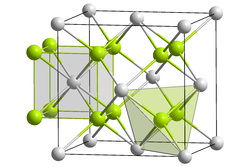Beryllium carbide
| Crystal structure | |||||||||||||||||||
|---|---|---|---|---|---|---|---|---|---|---|---|---|---|---|---|---|---|---|---|

|
|||||||||||||||||||
| __ Be 2+ __ C 4− | |||||||||||||||||||
| General | |||||||||||||||||||
| Surname | Beryllium carbide | ||||||||||||||||||
| Ratio formula | Be 2 C | ||||||||||||||||||
| Brief description |
yellow-red crystals |
||||||||||||||||||
| External identifiers / databases | |||||||||||||||||||
|
|||||||||||||||||||
| properties | |||||||||||||||||||
| Molar mass | 30.03 g · mol -1 | ||||||||||||||||||
| Physical state |
firmly |
||||||||||||||||||
| density |
1.90 g cm −3 (20 ° C) |
||||||||||||||||||
| Melting point |
> 2100 ° C (decomp.) |
||||||||||||||||||
| solubility |
reacts slowly with water |
||||||||||||||||||
| safety instructions | |||||||||||||||||||
|
|||||||||||||||||||
| As far as possible and customary, SI units are used. Unless otherwise noted, the data given apply to standard conditions . | |||||||||||||||||||
Beryllium carbide is a chemical compound made up of beryllium and carbon .
Manufacturing
Beryllium carbide can be made from the elements. An exothermic reaction sets in at 900 ° C and heats the reaction mixture to 1400 ° C.
Beryllium oxide and carbon can also react at high temperatures.
Carbon monoxide is produced at higher temperatures .
properties
Beryllium carbide forms yellow-red cubic crystals that slowly react with water to form beryllium hydroxide and methane .
Since the beryllium hydroxide formed is amphoteric, the reaction is accelerated in the presence of alkali hydroxides with the formation of water-soluble berylates.
This gives for the entire water-catalyzed reaction:
Fluorine , chlorine and bromine react with beryllium carbide in the heat to form the corresponding beryllium halides with the formation of carbon.
Individual evidence
- ↑ a b c d e Dale L. Perry, Sidney L. Phillips: Handbook of inorganic compounds . CRC Press, 1995, ISBN 978-0-8493-8671-8 , p. 62 ( limited preview in Google book search).
- ↑ Entry on beryllium compounds in the GESTIS substance database of the IFA , accessed on February 1, 2016 (JavaScript required)
- ↑ Not explicitly listed in Regulation (EC) No. 1272/2008 (CLP) , but with the indicated labeling it falls under the group entry beryllium compounds with the exception of aluminum beryllium silicates, and with those specified elsewhere in this Annex in the Classification and Labeling Inventory of the European Chemicals Agency (ECHA), accessed on February 1, 2016. Manufacturers or distributors can expand the harmonized classification and labeling .
- ↑ Kenneth A. Walsh: "Beryllium chemistry and Processing", ASM International (2009). p. 117 ( limited preview in Google Book search)
- ↑ a b c C. L. Parsons: "The Chemistry and Literature of Beryllium", Chemical Publishing (1909), p. 26. Full text
- ^ K. Motzfeld: "Equilibrium of the Reaction between Beryllium Oxide and Carbon to Give Beryllium Carbide" in Acta Chemica Scandinavica 1964 , 18 , p. 495-503. doi : 10.3891 / acta.chem.scand.18-0495
- ↑ Entry at chemicals.etacude.com
- ^ Lecture notes: "Chemistry of Metals", University of Freiburg









